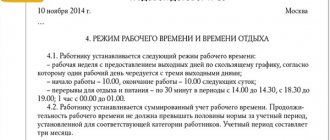How to use the calculator
To find out how much an employee worked, you need to enter the following information into the calculator:
Step 1. Indicate the time that the employee actually worked during the reporting period. Please note that hours and minutes must be entered separately: each has its own field.
Step 2. Now enter into the calculator how many hours and minutes the employee should work according to his schedule.
Step 3. It remains to indicate to the calculator whether it worked on weekends and holidays, and for how long.
Step 4. There is no need to click anywhere. Once all fields are filled in, the recycling calculator will automatically calculate the time. The result will appear directly below the last field of the calculator.
What counts as recycling?
Overtime work is not every overtime. For example, if an employee voluntarily stays late at work, then there is no point in applying for increased pay. Then what hours should be considered paid?
It is important to comply with two requirements enshrined in Article 99 of the Labor Code of the Russian Federation:
- the period of work goes beyond the standard working hours of a specialist, that is, it does not coincide with the length of the working day or shift;
- overtime has to be done at the insistence of the company management, that is, the employee’s own initiative does not apply to overtime work.
If you systematically stay late without a corresponding order from your superiors, you should not expect a double salary. It is important for both the employee and the employer to remember to observe labor discipline. Follow the rules:
- The employer notifies the subordinate of the need to engage in overtime work.
- A specialist can only be engaged with his written consent. Some employees should not be involved in non-standard work at all (pregnant women, minors). Certain categories of specialists must be notified of the right to refuse such an offer (disabled people, for example).
- Having agreed on non-standard work, the employer issues an order setting out all the necessary conditions. For example, the duration of processing, payment, working conditions, etc.
- Interested persons are familiarized with the order. Then the order is transferred to the accounting service for calculations.
The accounting employee calculates wages taking into account the actual volume of processing, payment terms and current norms of the Labor Code of the Russian Federation.
IMPORTANT!
If the employee’s employment contract states that he works on an irregular work schedule, then there should be no talk of overtime. Increased pay for overtime hours is offset by additional rest time. That is, instead of a cash payment to an employee who works irregular hours, additional days of vacation are provided. The conditions for additional rest time must be enshrined in the collective agreement.
How is work in excess of established working hours documented?
The procedure for processing work outside the established standards is presented in the following stages:
- Obtaining written consent for additional work from employees (the exception is the above situations when an employee can be involved in overtime work without approval). For these purposes, special notices are prepared for each employee, in which the employee will be able to sign, confirming his consent to additional work. The notice must contain:
- start date of overtime work;
processing time in hours.
- Drawing up an order for overtime work. The legislator did not provide a unified form for such an order, therefore the order is drawn up in the usual form for such documents in accordance with the internal record keeping rules of a particular enterprise. The order must contain information about:
- the reason that prompted you to organize additional work;
employees who are involved in such work (positions, personnel numbers, names);
- duration of processing (beginning and ending of additional work).
- Excessive hours worked are recorded in the time sheet for each employee.
The only difference in the procedure for processing overtime for employees for whom summary recording of working time is used is that the duration of overtime is calculated based on the results of the reporting period. Otherwise, labor legislation does not provide for any exceptions on this issue.Important! When processing overtime, you must not violate the requirements for the duration of additional work established by the Labor Code - no more than 4 hours for 2 days in a row and no more than 120 hours per year.
In addition, the same document can include a proposal for the employee to choose compensation for overtime: additional payment or additional days off (Article 152 of the Labor Code of the Russian Federation).
Employees get acquainted with the order and sign it.
How are processing times calculated?
The working hours for each specialist are calculated separately. For example, a 40-hour work week is considered the standard (Article 90 of the Labor Code of the Russian Federation). But for some specialists, reduced work hours are established. For example, for teachers or doctors. For them, the calculation of overworked hours is not calculated from the 40-hour week, but from the reduced norm.
The volume of processing is strictly limited by law. The following cannot be involved in overtime work (Part 6, Article 99 of the Labor Code of the Russian Federation):
- 4 hours two days in a row;
- more than 120 hours per year.
Overtime hours should be recorded on time sheets. The procedure for reflecting overtime depends on the form of the report card used in the organization.
The calculation of overtime fees depends on the duration. For the first two hours you will be paid one and a half times the standard rate. For the rest of the time - no less than double the amount. The norms are regulated in Art. 152 Labor Code of the Russian Federation.
The employer has the right to increase overtime pay rates. The specific amount of allowances is determined individually, depending on the financial situation of the company. But you cannot pay less than what is enshrined in the Labor Code. The specific amounts of payments should be fixed in a local act of the organization. The legislation does not contain a minimum or maximum amount of payments.
IMPORTANT!
An employee has the right to refuse an increased premium for overtime work, replacing the money with additional rest time. To do this, the subordinate must write an application for time off. This must be done no later than the last day of the month or billing period in which the processing took place.
How to calculate overtime
The procedure for calculating overtime depends on the method of recording working time at the enterprise.
For daily or weekly accounting, it is enough to know the standard working hours for a specific employee for the required period. So, with a standard 40-hour norm per week with 5 working days, the work norm per day will be 8 hours, with 6 working days - 5 days of 7 hours and 1 day of 5 hours (Article 95 of the Labor Code of the Russian Federation). If the calculation is made for an employee whose standard working time is a 36-hour week, his working time per day for a 5-day job should not exceed 7.2 hours.
For the convenience of calculations, most accountants and HR workers use a production calendar for the current year, compiled on the basis of transfers of weekends and holidays approved by the Government of the Russian Federation. The production calendar has already calculated the norms of hours per month for different options for maximum working hours per week. Specialists can only compare the time actually worked by a specific employee with the standards given in such a calendar. If there are surpluses, they will be recycled.
When accounting for working hours in total, you first need to determine the normal number of working hours for the reporting period. For example, if the reporting period is a quarter, the working time standard for the third quarter (July, August, September), in accordance with the production calendar for 2021, is:
- with a 40-hour work week - 528 hours;
- at 36 hours - 475.2 hours;
- at 24-hour - 316.8 hours.
Next, it remains to sum up the time worked by a specific employee for the specified period and, if the hours worked turn out to be more than the established standard working time, subtract the hours of standard working time. The resulting result will be processing.
Note: when accounting for labor time in aggregate, overtime is considered such if it occurred at the end of the reporting period.
Salary calculation
Salary or tariff rate is the most common form of remuneration in Russia. The employer assigns the employee a specific salary or rate for a fully worked norm. The calculation of overtime working hours at a salary is calculated based on the hourly share of the salary or rate.
First, the accountant calculates the cost of one hour of work for a specific specialist. There are several ways to calculate the hourly rate. For example, it is enough to divide the official salary by the number of working hours in the billing month. Or another option: we divide the salary by the average annual working time (standard working hours per year / 12 months).
IMPORTANT!
The method for calculating the hourly share of the salary or tariff rate must be enshrined in the local acts of the institution. Calculation based on the average annual working time is more beneficial for workers (Letter of the Ministry of Labor dated 08/09/2002 No. 1202-21).
The result obtained remains to be multiplied by the number of hours worked, taking into account the increasing factor. That is, we multiply the hourly salary by a factor of 1.5 for the first 2 overtime hours. The remaining processing time is calculated with a factor of 2.
Calculation example
A.P. Morkovkin’s official salary — 50,000 rubles. In May 2020, the standard working hours was 144. Processing in May was 5.5 hours.
We calculate the additional payment for processing:
- We calculate the hourly salary: 50,000 / 144 hours = 347.22 rubles.
- We calculate the additional payment for the first 2 hours: 347.22 × 1.5 × 2 hours = 1041.66 rubles.
- We calculate the remaining processing time: 5.5 - 2 hours = 3.5 hours.
- Calculation of the allowance for the rest of the time: 347.22 × 2 × 3.5 = 2430.54 rubles.
Total additional payment for processing: 1041.66 + 2430.54 = 3472.20 rubles.
The employee has the right to refuse increased pay and replace it with additional rest time.
IMPORTANT!
Additional payment for work in non-standard conditions from 04/11/2019 cannot be taken into account when comparing earnings with the minimum wage (Decision of the Constitutional Court of the Russian Federation No. 17-P of 04/11/2019). Therefore, additional payment for night, holiday, weekend or overtime work is calculated in excess of the minimum wage.
How is processing work paid?
Processing must be compensated, and compensation is possible (Article 152 of the Labor Code of the Russian Federation):
- in cash;
- in the form of additional rest time.
In this case, monetary compensation is a priority; additional rest is provided only when the employee requests it.
Overtime is paid in accordance with the norms of the Labor Code, in the following order:
- the first 2 hours of overtime - one and a half times the payment or more;
- subsequent hours - double pay or more.
As you can see, the code establishes only minimum values for payment for unscheduled work. This means that the organization, through its internal documents, can provide for higher rates for overtime pay.
Calculation for shift schedule
An eight-hour workday is not convenient for all companies. For example, in the manufacturing sector, businesses need to operate around the clock. Such organizations use shift work. The conditions of shift work are fixed in the employment contract.
If the employer had to hire an employee to work on a shift other than his own, he will have to pay double for the work. If shifts fall at night, specialists are entitled to an increase of at least 20%. If the shift falls on a holiday, then double pay is guaranteed. If the work shift falls on a holiday night, then the employee is entitled to two payments at once: separately for the night hours and separately for the holiday shift.
Calculation of overtime during a shift work schedule is carried out according to a similar scheme. First, the cost of an hour of work is calculated, and then multiplied by the hours worked and increasing factors. There are no exceptions for shift workers: for the first 2 hours the employer must charge a payment of no less than 1.5 times the amount. For the remaining hours - no less than double.
Calculation taking into account shift work schedule
When calculating the amount of payment for overtime hours during a shift work schedule, it is advisable to use the summarized accounting of working hours in the accounting period. The accounting period can be any period of time from one month to one year.
If we return to our example above about loader A. and slightly change the conditions, then the calculation will be made as follows.
With the previous salary of 15,000 rubles, we will take one month as the accounting period, during which the loader worked 176 hours, while the standard hours for the same month are 159.
In total, loader A. worked 17 hours above the norm. We make the calculation:
- we calculate wages for standard hours - 176 × (15000/159) = 16,603.77 for 159 hours;
- We calculate the additional payment for hours worked in excess of 17 hours. We multiply the first two hours by a factor of one and a half, all subsequent hours by a factor of 2. From the example above, we remember that an hour of work for a loader costs 91.40. Thus, 91.40 × 2 × 1.5 = 274.20 rubles. for the first two overtime hours and 91.30 × 15 × 2 = 2848.20 for the remaining overtime hours;
- We calculate the payment for 17 hours worked overtime - 274.20 + 2849.20 equals 3133 rubles payable.
Calculation example
Zaichikov P.B. works in shifts. The duration of 1 shift is 12 hours. The cost of a shift is 2,400 rubles. Night hours are paid at 20% of the rate. In April, the employer engaged Zaichikov to work overtime twice: on April 10 - for 3 hours and on April 15 - for 4 hours. Moreover, the overtime on April 15 fell at night.
We make the calculation:
- We calculate the cost of an hour: 2400 / 12 hours = 200 rubles.
- Additional payment for 04/10/2019: 200 × 1.5 × 2 hours + 200 × 2 × 1 hour = 600 + 400 = 1000 rubles.
- Additional payment for 04/15/2019: 200 × 1.5 × 2 hours + 200 × 2 × 2 hours = 600 + 800 = 1200 rub.
- We calculate the additional payment for night work: 200 × 4 hours × 20% = 160 rubles.
Total: 2360 (1000 + 1200 + 160) rubles.
Calculation example
The NPO Primer has established a summarized recording of working time. The billing period is quarter. Employee Kartoshkin I.N. The hourly tariff rate is set at 300 rubles. The norm for the 1st quarter of 2021 is 454 hours. In fact, Kartoshkin worked 462 hours. We make the calculation:
- We calculate the volume of processing: 462 - 454 = 8 hours.
- We calculate the additional payment for the first 2 hours: 300 × 1.5 × 2 hours = 900 rubles.
- Calculation of remaining time: 8 - 2 = 6 hours.
- We calculate the payment for the rest of the time: 300 × 2 × 6 hours = 3600 rubles.
Total amount of additional payment: 4500 (900 + 3600) rubles.










